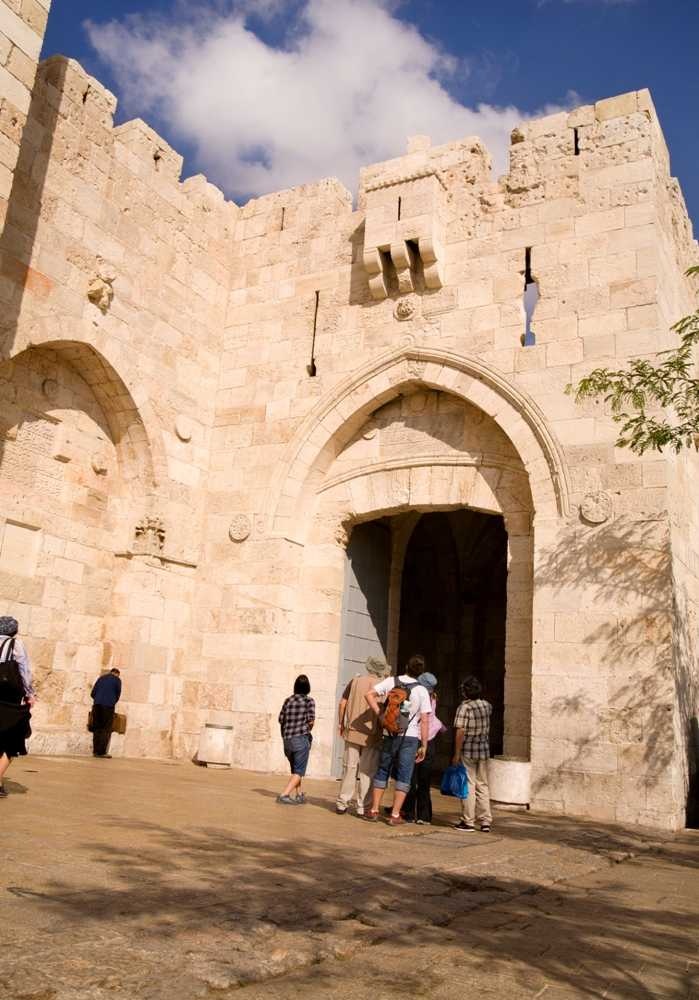Outside the gate is a stone plaza from where you can look out towards the magical scenery of Jerusalem. Those who enter through the gate can see on the left two Muslim tombs that belong to the engineers who built the wall, according to legend. From the Jaffa Gate Plaza, you can also enter and walk the Northern Walls Promenade and the Southern Walls Promenade, which lead to a fascinating observation tour on the back of the Old Wall or visit the Tower of David Museum of the History of Jerusalem. David Street (named after the tower) descends from the gate towards the bustling market of the old city.
About the history of the Jaffa Gate
The Jaffa Gate is one of the Ottoman city wall's most beautiful and important gates from the 16th century. The gate is named after Jaffa - the city to which the road leading from here leads. In Arabic, the gate is called "Bab al-Khalil", the name of the city of Hebron to which the road leads south from the Jaffa Gate.
Despite being active and lively in different periods, the Jaffa Gate lost its importance with the city's development to the west. In the past, it was a vibrant and central place, a meeting point for merchants, travelers, and passers-by bustling with constant activity. The British changed the face of the gate and removed the clock tower built above it in honor of the Turkish Sultan Abdul Hamid II at the beginning of the 20th century.
Looking at the gate from the outside, we can see the firing slits and the additional defense measures incorporated into the gate. Among them is an entrance at an angle of 90 degrees designed to slow the movement of invaders who wanted to enter the city, and massive doors locked every night until the end of the 19th century. Above the gate, we can see an overhead fighting cell called Mishikuli, used for observation and pouring boiling oil on unwanted guests. Additionally, we see an inscription engraved in stone, blessing Allah and the glorious Sultan Suleiman, who built the old city's gate and walls.
Outside the gate a stone plaza from which you can look out over the landscape of Jerusalem: to the south, you can see the windmill of Mishkenot Shananim, and next to it, the red tile roofs of Yemin Moshe and the King David Hotel. Below the hotel, we will notice white domes: these houses of the luxury Kfar David neighborhood built at the end of the 20th century on the ruins of the Mamilla neighborhood, a central commercial area of Jerusalem until 1948. The glass pyramid belongs to the center of Reform Judaism in Jerusalem. To the right of Kfar David, further along, the extension, the boulevard of shops of the commercial center "Alrov-Sderot Mamilla," which recreates the commercial street that was here until December 1947.
If we enter through the gate to the old city, we can see on the left two Muslim tombs. These are two Ottoman tombs: legend has it that the two engineers who built the wall for the glorious Sultan Suleiman were buried here. Immediately after they finished building the wall, the Sultan beheaded them. Some say that they were punished for not building the wall exactly as the Sultan requested since they did not include Mount Zion within the boundaries of the wall. Others claim that the Sultan feared that the engineers would build a wall as beautiful as it elsewhere in the world.
The nearby road, through which the cars pass into the Old City, was specially paved for the entourage of the German Emperor Wilhelm II when he visited Jerusalem in 1898. To this end, the moat that previously surrounded the city citadel was filled, and an access road to the Jaffa Gate was paved. Wilhelm himself wanted to enter the city gates as a crusader. Therefore, he entered the city on horseback.
From the Jaffa Gate plaza, we can also enter and walk along the Northern Walls Promenade and the Southern Walls Promenade, which lead us to a fascinating observation tour on the back of the ancient wall (for a fee).











